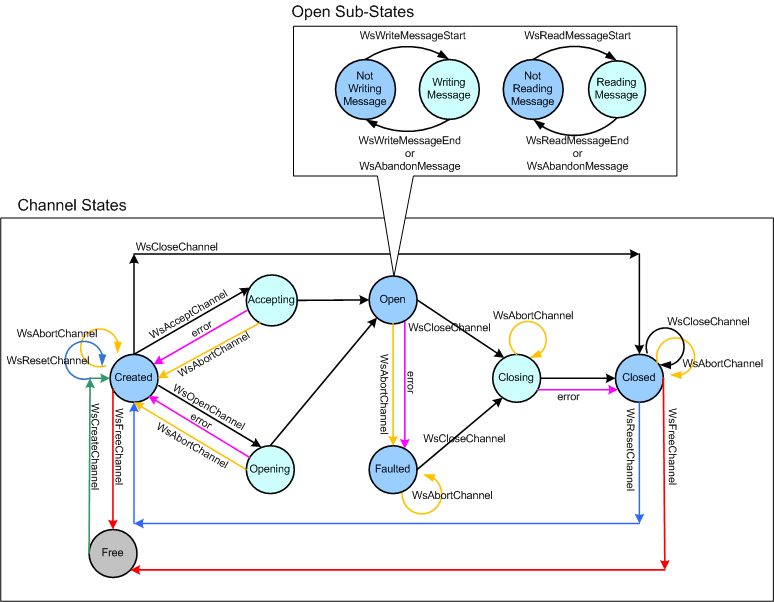énumération WS_CHANNEL_STATE (webservices.h)
Les différents états dans lequel un canal peut se trouver.
Syntax
typedef enum {
WS_CHANNEL_STATE_CREATED = 0,
WS_CHANNEL_STATE_OPENING = 1,
WS_CHANNEL_STATE_ACCEPTING = 2,
WS_CHANNEL_STATE_OPEN = 3,
WS_CHANNEL_STATE_FAULTED = 4,
WS_CHANNEL_STATE_CLOSING = 5,
WS_CHANNEL_STATE_CLOSED = 6
} WS_CHANNEL_STATE;
Constantes
WS_CHANNEL_STATE_CREATEDValeur : 0 |
WS_CHANNEL_STATE_OPENINGValeur : 1 |
WS_CHANNEL_STATE_ACCEPTINGValeur : 2 |
WS_CHANNEL_STATE_OPENValeur : 3 |
WS_CHANNEL_STATE_FAULTEDValeur : 4 |
WS_CHANNEL_STATE_CLOSINGValeur : 5 |
WS_CHANNEL_STATE_CLOSEDValeur : 6 |
Remarques
Voici les transitions d’état pour un canal.

Un canal peut passer à l’état WS_CHANNEL_STATE_FAULTED même si WsAbortChannel n’a jamais été appelé. Cela se produit uniquement si le canal ne peut plus être utilisé.
Notez que seules les transitions d’état valides sont affichées. L’utilisation d’une fonction non affichée pour un état donné entraîne le retour d’une erreur WS_E_INVALID_OPERATION à partir de la fonction (ou le blocage dans le cas de WsFreeChannel). Pour plus d’informations sur les codes d’erreur, consultezValeurs de retour des services Web Windows.
Configuration requise
| Condition requise | Valeur |
|---|---|
| Client minimal pris en charge | Windows 7 [applications de bureau uniquement] |
| Serveur minimal pris en charge | Windows Server 2008 R2 [applications de bureau uniquement] |
| En-tête | webservices.h |